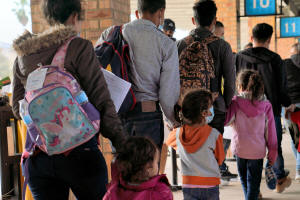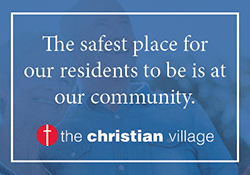Explainer: Why more migrant children are arriving at the U.S.-Mexico
border
 Send a link to a friend
Send a link to a friend
 [March 18, 2021]
By Ted Hesson and Mica Rosenberg [March 18, 2021]
By Ted Hesson and Mica Rosenberg
WASHINGTON (Reuters) - The number of
migrants arriving at the U.S.-Mexico border this year is on pace to be
the highest in 20 years, one of U.S. President Joe Biden's top officials
said this week, a rise that includes an increase in unaccompanied
children.
The Biden administration has struggled to house the growing number of
children arriving without a parent or legal guardian, which has left the
kids stuck in jail-like border facilities for days. Republicans have
blamed Biden for relaxing immigration policies, while some Democrats are
concerned about conditions in facilities and why children are being held
for so long.
Biden, a Democrat who took office on Jan. 20, pledged to reverse many of
the hard-line border policies of his Republican predecessor, former
President Donald Trump. But less than two months into his presidency, he
is dealing with an emerging humanitarian and political crisis.

WHO ARE THE UNACCOMPANIED CHILDREN ARRIVING AT THE BORDER?
About two-thirds of unaccompanied children caught at the border since
Oct. 1, 2020, have been from Guatemala, El Salvador and Honduras,
according to U.S. Customs and Border Protection (CBP). Mexican children
make up most of the remainder.
As of Tuesday, about 9,200 unaccompanied children were in the custody of
a U.S. Department of Health and Human Services (HHS) refugee office that
manages a government shelter system for the kids - the highest number
since 2019.
Most of the kids in custody are teenagers, but hundreds are under 12
years old. The majority of unaccompanied children apprehended since Oct.
1, 2020, crossed through Texas' Rio Grande Valley, according to CBP.
WHY ARE SO MANY KIDS COMING TO THE BORDER?
Many unaccompanied children come to the United States to reunite with
family members or escape violence and poverty in their home countries,
according to immigration experts.
Central America has recently been battered by hurricanes and slumping
economies in the wake of the COVID-19 pandemic, which has spurred more
migration.
Republicans argue Biden has encouraged illegal immigration by rolling
back Trump's policies. But border arrests have been gradually rising
since a sharp decline in April 2020 as countries shut borders due to the
pandemic.

Biden told ABC in an interview on Tuesday that it was nonsense that more
migrants were coming because he is "a nice guy," saying "they come
because their circumstance is so bad."
Biden officials and migrant advocates, however, acknowledge that the
current increase is at least partly due to a recent policy change that
now allows unaccompanied children into the country.
The Biden administration continues to expel single adults and families
crossing illegally, with some exceptions.
There were similar spikes in 2019 and 2014 under Trump and former
President Barack Obama, respectively.
ARE THE CHILDREN TRULY UNACCOMPANIED?
Some children do make the potentially dangerous trip to the border alone
or with a smuggler, according to immigration experts. But in other
cases, children travel with older siblings, grandparents or other
relatives, and can be split apart by CBP after being caught at the
border.
Currently, immigrant advocates are concerned that parents may be
traveling to the border with their children and sending them to the
United States alone so that they will be permitted to enter.
If the parents and children entered as a family, they could be expelled
under Title 42, a Trump-era health order to limit the spread of
COVID-19.
[to top of second column]
|

Central American children walk in line with their parents after
being dropped off by Border Patrol at the bus station in
Brownsville, Texas, U.S. March 15, 2021. Picture taken March 15,
2021. REUTERS/Veronica G. Cardenas/

WHAT HAPPENS WHEN A CHILD ARRIVES AT THE BORDER?
Children are supposed to be transferred out of CBP custody to HHS-run
shelters within 72 hours.
But when shelter space is limited, children can get stuck in border
detention centers for longer periods - as is happening now.
The border stations were built to house adult men for short periods
and could pose a COVID-19 health risk to children and staff if they
are overcrowded.
Once in the shelters, children can be released to parents or other
sponsors, or placed in foster care. They can then pursue asylum
cases, seek other ways to remain in the United States or potentially
be deported - although that is unlikely to happen quickly.
The United States removed only 4% of the roughly 290,000
unaccompanied children who entered the country from fiscal year 2014
to fiscal year 2019, according to U.S. Department of Homeland
Security (DHS) data.
WHAT ARE THE CONDITIONS IN BORDER PATROL FACILITIES?
CBP facilities are not open to the public. But lawyers representing
children in a decades-old class action lawsuit visited a facility in
Donna, Texas, on March 11.

They found the facility packed with about 1,800 children, some as
young as 1, said Leecia Welch, one of the lawyers, with conditions
that suggested it was "vastly over capacity."
Several children described sleeping on the floor or on metal
benches, she said. The children were only allowed outside a few
minutes every few days.
"They wanted fresh air and to see the sky," Welch said.
WHAT IS THE U.S. DOING TO DEAL WITH THE INCREASE?
The Biden administration is creating joint processing centers to
transfer the children promptly into HHS custody after they arrive at
the border, DHS Secretary Alejandro Mayorkas said on Tuesday.
The administration has opened several emergency shelters for
children in Texas and plans to use the Dallas convention center to
house up to 3,000 migrant teen boys.
The Federal Emergency Management Agency (FEMA) - which usually
responds to floods, storms and other major disasters - was deployed
on Saturday to help shelter and transport children at least until
early June.
In the longer-term, Biden is trying to establish programs that allow
Central Americans to apply for refugee status in the United States
from their home countries and improve conditions in those countries.
As part of that effort, the administration announced the restart of
a program that allows certain Central American children with parents
lawfully living in the United States to apply for a refugee
resettlement from their home countries.

Biden has pledged to push for $4 billion in U.S. aid for Central
America to help address the factors that drive migration, such as
poverty and crime.
(Reporting by Ted Hesson in Washington and Mica Rosenberg in New
York; Additional reporting by Mimi Dwyer in McAllen, Texas, and
Kristina Cooke in San Francisco; editing by Ross Colvin and Aurora
Ellis)
[© 2021 Thomson Reuters. All rights
reserved.] Copyright 2021 Reuters. All rights reserved. This material may not be published,
broadcast, rewritten or redistributed.
Thompson Reuters is solely responsible for this content. |